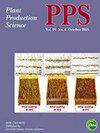Effects of temperature during ripening on amylopectin chain-length distribution of ‘Koshihikari’ and ‘Ichihomare’
IF 1.3
3区 农林科学
Q2 AGRONOMY
引用次数: 2
Abstract
ABSTRACT Because of global warming, the ripening period of rice (Oryza sativa L.) is becoming hotter in Japan, and there is concern that eating quality will decline as a result. Amylopectin is the largest component of rice endosperm starch and its short-chain content has a considerable effect on the eating quality of cooked rice. Here we investigated the effect of high temperature during ripening on amylopectin chain-length distribution in ‘Koshihikari’, the leading cultivar in Japan, and in ‘Ichihomare’, released in 2017 and grown in Fukui prefecture, ripened in paddies over multiple years. The amylopectin short-chain content of degree-of-polymerization (DP) 6–13 of ‘Koshihikari’ grain ripened at high temperature was 3.03 points lower than that of grain ripened at low temperature. In contrast, that of ‘Ichihomare’ was only 0.26 points lower. For every 1°C increase in temperature during ripening, the short-chain content of DP 6–13 of ‘Koshihikari’ decreased linearly by 1.03 points whereas that of ‘Ichihomare’ did not decrease significantly. These results suggest that the amylopectin chain-length distribution of ‘Ichihomare’ might be more stable to temperature during ripening than that of ‘Koshihikari’. The reason is yet unknown, but this trait will contribute to breeding and production of cultivars with stable good eating quality under high temperatures during ripening. Graphical abstract成熟期温度对‘Koshihikari’和‘Ichihomare’支链淀粉链长分布的影响
由于全球气候变暖,日本水稻的成熟期越来越热,人们担心稻米的食用质量会因此下降。支链淀粉是水稻胚乳淀粉的最大成分,其短链含量对熟米的食性有相当大的影响。在这里,我们研究了催熟过程中高温对日本主要品种‘Koshihikari’和‘Ichihomare’支链淀粉链长分布的影响,这两个品种于2017年发布,在福井县种植,在稻田中成熟多年。高温成熟的‘光’籽粒聚合度(DP) 6-13支链淀粉短链含量比低温成熟籽粒低3.03点。相反,“Ichihomare”的得分仅低0.26分。成熟过程中,温度每升高1℃,Koshihikari的DP 6-13短链含量线性下降1.03个点,而Ichihomare的DP 6-13短链含量线性下降不显著。这些结果表明,在成熟过程中,“Ichihomare”的支链淀粉链长分布可能比“Koshihikari”更稳定。原因尚不清楚,但这一特性将有助于育种和生产成熟高温下稳定优良食性的品种。图形抽象
本文章由计算机程序翻译,如有差异,请以英文原文为准。
求助全文
约1分钟内获得全文
求助全文
来源期刊

Plant Production Science
农林科学-农艺学
CiteScore
5.10
自引率
4.00%
发文量
27
审稿时长
>36 weeks
期刊介绍:
Plant Production Science publishes original research reports on field crops and resource plants, their production and related subjects, covering a wide range of sciences; physiology, biotechnology, morphology, ecology, cropping system, production technology and post harvest management. Studies on plant production with special attention to resource management and the environment are also welcome. Field surveys on cropping or farming system are also accepted. Articles with a background in other research areas such as soil science, meteorology, biometry, product process and plant protection will be accepted as long as they are significantly related to plant production.
 求助内容:
求助内容: 应助结果提醒方式:
应助结果提醒方式:


